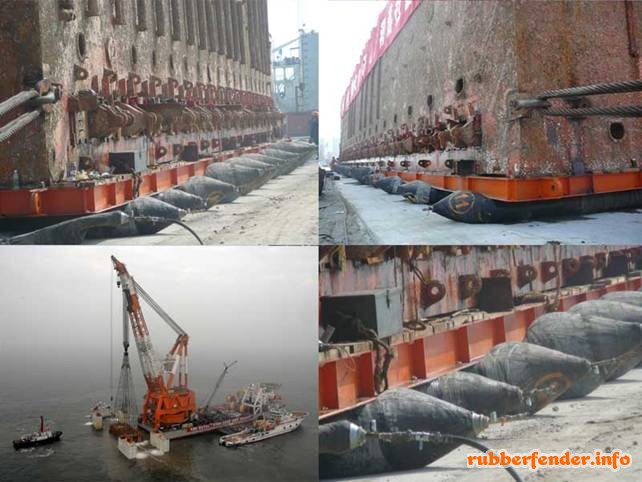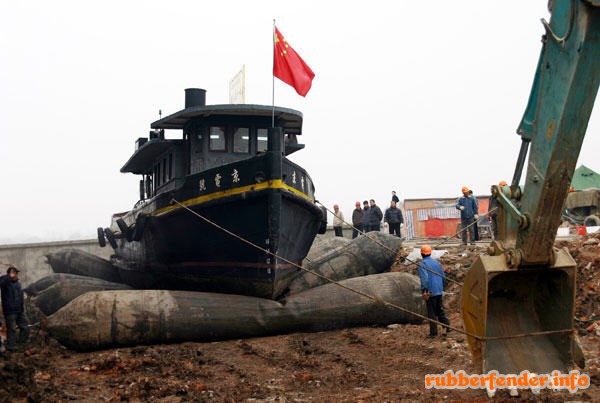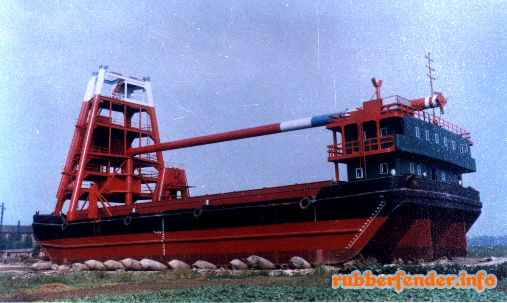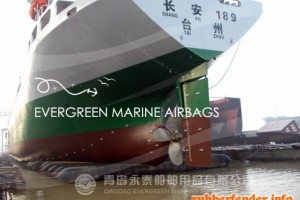ship launching & vessel haul-out by marine airbags (also called ship launching airbags) is an innovative technology. It overcomes the disadvantages of traditional end-launching or side-launching methods and can save customers’ most time and budget. In China more than 80 percent new built ship whose DWT below 60,000 are launched by marine airbags.


What we can do:
Eversafe Marine Engineering offer total pack for launch and haul-out projects which include launch design, airbags supply, on site support and worker training also we can provide launch or haul out service according to demand. After years of practice and accumulation of experience, we have developed this ship launching techniques from facilitating the launching of only 1,000 DWT ships to current 60,000 DWT ships. And now this launching technology has become into a flexible, promising, secure and mature technology. Besides that, Eversafe marine airbags are widely used in launching and haul-out of vessels of all sizes.
Eversafe Marine Engineering offer total pack for launch and haul-out projects which include launch design, airbags supply, on site support and worker training also we can provide launch or haul out service according to demand. After years of practice and accumulation of experience, we have developed this ship launching techniques from facilitating the launching of only 1,000 DWT ships to current 60,000 DWT ships. And now this launching technology has become into a flexible, promising, secure and mature technology. Besides that, Eversafe marine airbags are widely used in launching and haul-out of vessels of all sizes.
Typical Airbag Ship Launch Projects Completed by Eversafe Marine
Advantages of Eversafe ship launching solution
Less land form limited
Only need enough bearing power ground and no sharp objects
Minimum fixture needed
Need no more than air compressors,winches and steel ropes
Environment Protective
Do no harm to the environment. No chemical needed.
Time & money saving
No construction need then save time and money. Marine airbags can be reused.
Less land form limited
Only need enough bearing power ground and no sharp objects
Minimum fixture needed
Need no more than air compressors,winches and steel ropes
Environment Protective
Do no harm to the environment. No chemical needed.
Time & money saving
No construction need then save time and money. Marine airbags can be reused.
Applicability of airbag ship launching
Actually the airbag launching feasibility of a specified vessel should be calculated first but there are some simple rules may help people to know launch feasibility quickly.
A majority of airbag ship launching is end launching but side launching is feasible when some rigorous conditions are satisfied.
Vessels whose DWT below 60,000 tonnes can be launched with airbags surely. Regarding bigger vessels only by calculation people can know the launch feasibility. Width of launching channel should be no less than 1.5 times of length of vessel
A majority of airbag ship launching is end launching but side launching is feasible when some rigorous conditions are satisfied.
Vessels whose DWT below 60,000 tonnes can be launched with airbags surely. Regarding bigger vessels only by calculation people can know the launch feasibility. Width of launching channel should be no less than 1.5 times of length of vessel
Airbag ship launching and haul out slipway design
The slipway's parameters which include length, width, slope angle, bearing capacity and elevation should be designed base on calculation results.
The length and width of airbag launching slipway’s can refer to traditional end launching slipway design.
The bearing capacity of airbag launching slipway can be lower than traditional slipway because airbags get more contact area than traditional launch trolleys. And that is why airbag ship launching can save slipway investment. According to the airbag launching calculation slipway’s capability should be 1.5 -2 times of the maximum airbags’ pressure.
Generally slipway for airbag launching and haul out will have shore part and under water part. The shore part has small slope angle and the underwater part has bigger angle which can give launched vessel more slide forward force and enable airbags roll out of bottom of vessel. The length, angle and structure of underwater part are very important for the success of launching and airbags’ safety. If possible concrete slipway is the best for airbag launching and haul out. For temporary vessel launching, strong enough ground is acceptable but slope angle should satisfy the demand.

The slipway's parameters which include length, width, slope angle, bearing capacity and elevation should be designed base on calculation results.
The length and width of airbag launching slipway’s can refer to traditional end launching slipway design.
The bearing capacity of airbag launching slipway can be lower than traditional slipway because airbags get more contact area than traditional launch trolleys. And that is why airbag ship launching can save slipway investment. According to the airbag launching calculation slipway’s capability should be 1.5 -2 times of the maximum airbags’ pressure.
Generally slipway for airbag launching and haul out will have shore part and under water part. The shore part has small slope angle and the underwater part has bigger angle which can give launched vessel more slide forward force and enable airbags roll out of bottom of vessel. The length, angle and structure of underwater part are very important for the success of launching and airbags’ safety. If possible concrete slipway is the best for airbag launching and haul out. For temporary vessel launching, strong enough ground is acceptable but slope angle should satisfy the demand.

Basic information we need for slipway design
1. Type of vessels?
2. LOA and length of vessels’ scope
3. Molded breadth of vessels’ scope
4. Vessels’ actual launched weights (gravity weight)/weight without cargo?
5. Draft of stern and bow
6. Water survey data of end of supposed slipway area
7. Tide schedule at site
8. Drawing of shipyard
1. Type of vessels?
2. LOA and length of vessels’ scope
3. Molded breadth of vessels’ scope
4. Vessels’ actual launched weights (gravity weight)/weight without cargo?
5. Draft of stern and bow
6. Water survey data of end of supposed slipway area
7. Tide schedule at site
8. Drawing of shipyard
Basic information need for design ship launching procedure
1. Type of vessel?
2. LOA and length of vessel?
3. Molded breadth of vessel?
4. Vessel's actual launched weight (gravity weight)/weight without cargo?
5. Block coefficient of vessel
9. Draft of stern and bow
10. Gravity center position
11. Type of ground ship is built on? (Dirt, concrete, etc.)
12. Height of wooden blocks that support vessel
13. Angle degree of slipway? (Land, not under water)
14. Water survey data of end of slipway area
15. Tide schedule at site
16. Distance from vessel stern to the end of slipway
17. Pictures of vessel ( stern,bow) and slipway

1. Type of vessel?
2. LOA and length of vessel?
3. Molded breadth of vessel?
4. Vessel's actual launched weight (gravity weight)/weight without cargo?
5. Block coefficient of vessel
9. Draft of stern and bow
10. Gravity center position
11. Type of ground ship is built on? (Dirt, concrete, etc.)
12. Height of wooden blocks that support vessel
13. Angle degree of slipway? (Land, not under water)
14. Water survey data of end of slipway area
15. Tide schedule at site
16. Distance from vessel stern to the end of slipway
17. Pictures of vessel ( stern,bow) and slipway


